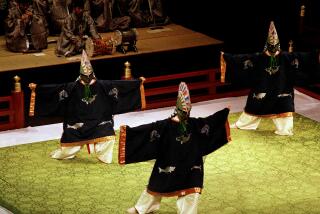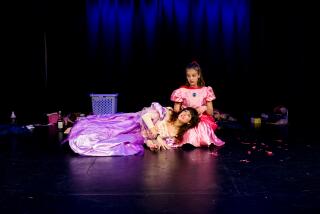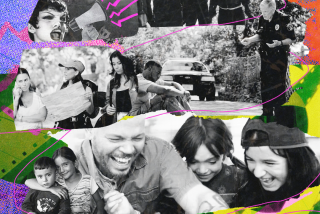ARTS FESTIVALS: SOME BUDDING AND SOME IN BLOOM : THIS ONE’S AIMED AT THE FRINGE
- Share via
Aaron Paley works in a makeshift office behind his home, kept company by some part-time helpers, a Macintosh computer and Spike, his dog. However, Paley, executive director of the Fringe Festival/Los Angeles, has a vision for the September arts celebration he’s organizing that extends far beyond the modest surroundings.
“I want people on the Westside, in theValley, downtown or in South-Central L.A. to see performances wherever they live, so that the festival atmosphere pervades everywhere,” said Paley, who lives near the Miracle Mile. “We want to have performances in parks, theaters, galleries, private lofts, even the zoo! . . . And we want to have street entertainers, literary arts, video, site-specific visual and performance art” in addition to dance, theater and music events.
The Fringe, modeled after the Edinburgh Festival Fringe, is scheduled to run concurrently with the Los Angeles Festival (Sept. 3-27). The Fringe will feature smaller Los Angeles arts troupes and individual artists, while the larger festival brings entertainment on a grander scale from around the world.
Paley, 29, has eight years’ experience in arts administration. He said he began his current job last September, after a national search conducted by the Fringe board of directors, which includes Thomas C. Schumacher, associate director of the Los Angeles Festival. The Fringe is acting independent of but in association with the larger festival, which has given it $25,000, Paley said.
(Another $10,000 from the California Community Foundation and $1,000 from the Dramatists Guild comprise the current Fringe budget. Paley said he is working “furiously” to raise more funds and hopes to find a corporate sponsor.)
“We’re working together in a symbiotic relationship,” Paley said. “For instance, downtown L.A. Festival-goers could go to a Fringe event before or after their own event--like when they exit the Japan America Theatre at 11 p.m., they could go over to LACE (Los Angeles Contemporary Exhibitions, a community gallery) to see something else. . . . I envision festival buses shuttling people from place to place, and something going on everywhere you can walk in L.A.--day and night.”
Robert Fitzpatrick, director of the Los Angeles Festival, heartily supports the collaboration: “I’m passionately attached to the Fringe,” he said. “I think the (larger) festival is much more exciting if there’s a whole configuration of activity also going on. . . . The success of the Los Angeles Festival will be partly determined if we’re able to inspire the Fringe--which perhaps, at some point, will be larger than the festival itself.”
Unlike participants in the Los Angeles Festival, Fringe artists won’t be selected by festival management, said Paley, a Los Angeles native with a master’s degree in arts management from UCLA. Fringe participants simply need to apply. Any individual artist or organization or arts producer may enter, he said, but the emphasis is primarily on smaller, nonprofit groups, those with annual budgets of $500,000 or less.
“We don’t go out and say, ‘ You can be in it, and you can’t’; everyone can be in it. And we don’t want to have to turn anyone away. It’s really important to me that everybody feels this is their festival. We’re not coming in with a preconceived aesthetic idea and saying, ‘This is great, you should be a part of it.’ ”
“We are also encouraging out-of-town artists to participate. Our emphasis is on the local scene, but it’s really to everyone’s benefit to see work from out of town on a smaller scale than Fitzpatrick’s festival.” (Paley predicted, however, as has Fitzpatrick, that the first Fringe will include mostly Southern California artists.)
The Fringe will help participants find performing venues, provide marketing and publicity and produce a festival schedule, Paley added. However Fringe staff will not produce events nor will participants be paid by the Fringe, he said. Fitzpatrick said the Fringe will be given a page in the Los Angeles Festival’s brochures.
(Prospective Fringe participants may apply for entry through June 1 and will be charged a sliding-scale fee, whose minimum is $100. Information: (213) 931-1255.)
Paley said that while he has just begun soliciting participants through the mail and by word of mouth, he thinks the Fringe will present about 200 events. “But if we don’t reach that number, I won’t feel it’s a failure. I think any size festival we manage to put together will be a success, because it’s really important for this to happen for the first time . . . and if it works, it will coincide every other year with the Los Angeles Festival.”
However, about 100 groups have expressed interest in joining the Fringe so far, Paley said, and about 50 groups he knows “for sure will be in it.” Those include Los Angeles Contemporary Exhibitions, the Cast Theater, the Woman’s Building community art gallery and the EZTV video center, he said. No dance or music groups have committed themselves yet.
“It’s too early,” Paley said. “People are just finding out about this. We don’t even have the entry forms printed yet.”
The idea to launch the Fringe came from a group of people within the Equity Waiver theater community that formed a board of directors to begin planning the festival about eight months ago, Paley said.
“This was really a response to the (1984) Olympic Arts Festival. The board wanted to develop a way for local theater not to be forgotten during the next festival. That was the original idea, but then it ballooned into a full, multidiscipline festival.”
To enlarge the Fringe scope beyond Los Angeles County, he said, he has launched a national outreach campaign, modeled on a plan he used in his last job as coordinator of a national dance touring program he ran in New York.
While Paley comes to his current position from the East, he has returned to his native town with a hefty share of civic pride.
“It’s really important for me to help the city this way,” he said, “and this could really contribute a lot. We’re pushing to take Los Angeles to the next level culturally.
“Community arts are also a real focus of the Fringe,” he said. “I hope I can get the Asian, Latino and black communities involved. This is not for highfalutin people, its really a mainstream festival for all of Los Angeles.”
More to Read
The biggest entertainment stories
Get our big stories about Hollywood, film, television, music, arts, culture and more right in your inbox as soon as they publish.
You may occasionally receive promotional content from the Los Angeles Times.










